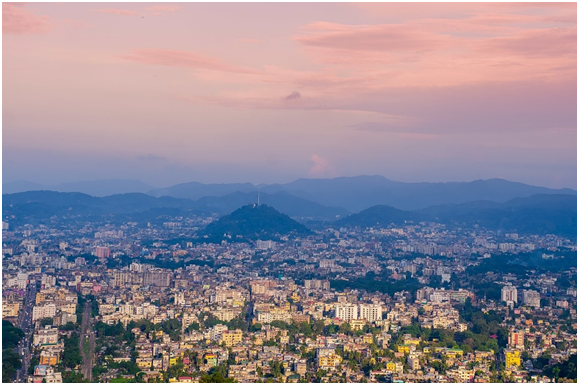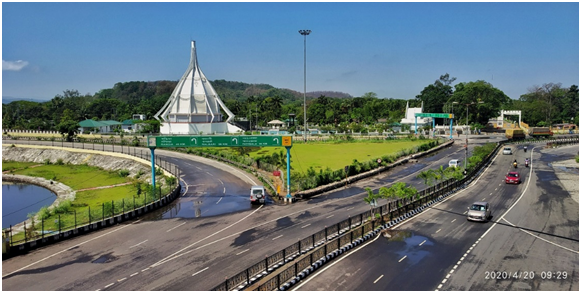



Dear Smiling Teammates,
I welcome you all to our 16th edition of Digital magazine ‘SpicyReflection’. This journey of 16 editions has been filled with Happiness, Motivation and Knowledge Ithas been possible because of the combined effort and with the support of each one of us.
‘If you are patient in one moment of Anger, you will escape a hundred days of sorrow’. In this June 2023 Edition of our magazine we will talk about ‘Anger Management’ under ‘Nurture your talent’ series and will showcase why Anger can be the biggest hurdle in our career growth.
In this edition we have included some great videos in our section ‘Hot Shots’ which will surely will make you smile. Keep Smiling ☺.
Let’s walk through the ‘Gateway of Northeast India’ as in this edition we will take you to the land of temples under ‘My City My Place’ series. Besides being known for its monuments and temples, it has several beautiful places to visit.
We would like to thank you all for your participation in SpicyReflection Quiz and also would like to congratulate Mr. T R Rajaganesh Ramanan from Chennai team for winning the SpicyReflection Quiz (May 2023 Edition). We wish all the best to all the other participants for our June 2023 Quiz.
Making people smile is one of the simplest yet most powerful things that we can do as human beings, and with our ‘Smile Campaign’ we have created moments of happiness within the team and also with our customers. Let’s keep the happiness quotient high for all our team members as well as for our passengers. We need to continue our focus on service with Eye contact, Smile and Greetings at all the customer touch points. We congratulate each one of you for your great efforts. Please keep it up!
We are sure you will enjoy this edition of SpicyReflection filled with knowledgeable and interesting facts. Please do share your feedback / ideas for the next edition. Also enjoy our fun filled social media page “SpicyReflection” on Instagram, Facebook and YouTube.
Keep Reading and Sharing!!
Jai Hind!
Your Captain
GP Gupta
What is Anger?
Anger is a normal, healthy emotion, neither good nor bad. Like any emotion, it conveys a message, telling you that a situation is upsetting, unjust, or threatening. So, while it’s perfectly normal to feel angry when you’ve been mistreated or wronged, anger becomes a problem when you express it in a way that harms yourself or others.
You might think that venting your anger is healthy, or that you need to show your fury to get respect. But the truth is that anger is much more likely to have a negative impact on the way people see you, impair your judgment, and get in the way of success.
Definition of Anger
Strong feeling of displeasure against something undesirable which has happened.
Effects of anger
Anger that flares up all the time or spirals out of control can have serious consequences for our:
Physical health. Constantly operating at high levels of stress and anger makes you more susceptible to heart disease, diabetes, a weakened immune system, insomnia, and high blood pressure.
Mental health. Chronic anger consumes huge amounts of mental energy, and clouds your thinking, making it harder to concentrate or enjoy life. It can also lead to stress, depression, and other mental health problems.
Career. Constructive criticism, creative differences, and heated debate can be healthy. But lashing out only alienates your colleagues, supervisors, or clients and erodes their respect.
Relationships. Anger can cause lasting scars in the people you love most and get in the way of friendships and work relationships.
Explosive anger makes it hard for others to trust you, speak honestly, or feel comfortable—and is especially damaging to children.
How anger management can help “US”?
Many people think that anger management is about learning to suppress your anger. But never getting angry is not a healthy goal. Anger will come out regardless of how hard you try to tamp it down. The true goal of anger management isn’t to suppress feelings of anger, but rather to understand the message behind the emotion and express it in a healthy way without losing control.
Mastering the art of anger management takes work, but the more you practice, the easier it will get. And the payoff is huge. Learning to control your anger and express it appropriately will help you build better relationships, achieve your goals, and lead a healthier, more satisfying life.
What's really behind your anger?
Have you ever gotten into an argument over something silly? Big fights often happen over something small, like being ten minutes late. But there’s usually a bigger issue behind it. If you find your irritation and anger rapidly rising, ask yourself, “What am I really angry about?” Identifying the real source of frustration will help you communicate your anger better, take constructive action, and work towards a resolution.
Is your anger masking other feelings such as embarrassment, insecurity, hurt, shame, or vulnerability? As an adult, you may have a hard time acknowledging feelings other than anger.
✈ Anger can also mask anxiety. When you perceive a threat, either real or imagined, your body activates the “fight or flight” response. To change your response, you need to find out what’s causing you to feel anxious or scared.
✈ Anger problems can stem from what you learned as a child. If you watched others in your family scream, hit each other, or throw things, you might think this is how anger is supposed to be expressed.
✈ Anger can be a symptom of another underlying health problem, such as depression, trauma, or stress.
There's more to your anger than meets the eye
✈ You have a hard time compromising.
✈ You view different opinions as a personal challenge.
✈ You have trouble expressing emotions other than anger. .
Warning signs of your Anger
While you might feel that you just explode into anger without warning, there are in fact physical warning signs in your body. Becoming aware of your own personal signs that your temper is starting to boil allows you to take steps to manage your anger before it gets out of control.
Pay attention to the way anger feels in your body
✈ Knots in your stomach
✈ Clenching your hands or jaw
✈ Feeling clammy or flushed
✈ Breathing faster
✈ Headaches
✈ Pacing or needing to walk around
✈ “Seeing red”
✈ Having trouble concentrating
✈ Pounding heart
✈ Tensing your shoulders
✈ Identify your triggers
Identifying Triggers and Responses along with Common negative thinking patters of Angers:
Stressful events don’t excuse anger, but understanding how these events affect you can help you take control of your environment and avoid unnecessary aggravation. Look at your regular routine and try to identify activities, times of day, people, places, or situations that trigger irritable or angry feelings.
Maybe you get into a fight every time you go out for drinks with a certain group of friends. Or maybe the traffic on your daily commute drives you crazy. When you identify your triggers, think about ways to either avoid them or view the situations differently so they don’t make your blood boil.
You may think that external factors—the insensitive actions of other people, for example, or frustrating situations—are causing your anger.
But anger problems have less to do with what happens to you than how you interpret and think about what happened.
✈ Overgeneralizing. For example, “You ALWAYS interrupt me. You NEVER consider my needs. EVERYONE disrespects me. I NEVER get the credit I deserve.”
✈ Obsessing over “shoulds” and “musts.” Having a rigid view of the way a situation should or must go and getting angry when reality doesn’t line up with this vision.
✈ Mind reading and jumping to conclusions. Assuming you “know” what someone else is thinking or feeling—that they intentionally upset you, ignored your wishes, or disrespected you.
✈ Collecting straws. Looking for things to get upset about, usually while overlooking or blowing past anything positive. Letting these small irritations build and build until you reach the “final straw” and explode, often over something relatively minor.
✈ Blaming. When anything bad happens or something goes wrong, it’s always someone else’s fault.
✈ You tell yourself, “life’s not fair,” or blame others for your problems rather than taking responsibility for your own life.
When you identify the thought patterns that fuel your anger.
Learning Strategies to diffuse Anger
Once you know how to recognize the warning signs that your temper is rising and anticipate your triggers, you can act quickly to deal with your anger before it spins out of control. There are many techniques that can help you cool down and keep your anger in check.
✈ Focus on the physical sensations of anger. While it may seem counter intuitive, tuning into the way your body feels when you’re angry often lessens the emotional intensity of your anger.
✈ Take some deep breaths. Deep, slow breathing helps counteract rising tension.
✈ Get moving. A brisk walk around the block is a great idea. Physical activity releases pent-up energy so you can approach the situation with a cooler head.
✈ Use your senses. You can use sight, smell, hearing, touch, and taste to quickly relieve stress and cool down. You might try listening to a favourite piece of music, looking at a treasured photo, savoring a cup of tea, or stroking a pet.
✈ Stretch or massage areas of tension. Roll your shoulders if you are tensing them
✈ Slowly count to ten. Focus on the counting to let your rational mind catch up with your feelings. If you still feel out of control by the time you reach ten, start counting again.
✈ Give yourself a reality check
Take a moment to think about the situation. Ask yourself:
How important is it in the grand scheme of things?
Is it really worth getting angry about it?
Is it worth ruining the rest of my day?
Is my response appropriate to the situation?
Is there anything I can do about it?
Is taking action worth my time?
Healthier ways to express your anger
Changing Attitude and Patterns to Diffuse Anger
If you’ve decided that the situation is worth getting angry about and there’s something you can do to make it better, the key is to express your feelings in a healthy way. Learning how to resolve conflict in a positive way will help you strengthen your relationships rather than damaging them.
✈ Make the relationship your priority. Maintaining and strengthening the relationship, rather than “winning” the argument, should always be your first priority. Respect the other person and their viewpoint.
✈ Focus on the present. Once you are in the heat of arguing, it’s easy to start throwing past grievances into the mix. Rather than looking to the past and assigning blame, focus on what you can do in the present to solve the problem.
✈ Be willing to forgive. Resolving conflict is impossible if you’re unwilling or unable to forgive. Resolution lies in releasing the urge to punish, which can never compensate for our losses and only adds to our injury by further depleting and draining our lives.
✈ Take five minutes if things get too heated. If your anger starts to spiral out of control, remove yourself from the situation for a few minutes or for as long as it takes you to cool down.
✈ Know when to let something go. If you can’t come to an agreement, agree to disagree. It takes two people to keep an argument going. If a conflict is going nowhere, you can choose to disengage and move on.
✈ Stay calm by taking care of yourself
Taking care of your overall mental and physical well-being can help ease tension and diffuse anger problems.
✈ Manage stress. If your stress levels are through the roof, you’re more likely to struggle controlling your temper.
✈ Talk to someone you trust. Nothing eases stress more effectively than chatting face-to-face with a friend or loved one.
✈ Get enough sleep. A lack of sleep can exacerbate negative thoughts and leave you feeling agitated and short-tempered.
✈ Exercise regularly. It’s an effective way to burn-off tension and ease stress, and it can leave you feeling more relaxed and positive throughout the day.
✈ Be smart about alcohol and drugs. They lower your inhibitions and can make it even harder to control your anger.
✈ Use humor to relieve tension. When things get tense, humor and playfulness can help you lighten the mood, smooth over differences, reframe problems, and keep things in perspective.
We all love people who are able to gently poke fun at their own failings. After all, we’re all flawed and we all make mistakes.
So, if you’ve made a mistake or you’ve just spilled coffee over yourself, instead of getting angry or picking a fight, try making a joke about it. Even if the joke falls flat or comes out wrong, the only person you risk offending is yourself.
When humor and play are used to reduce tension and anger, a potential conflict can even become an opportunity for greater connection and intimacy.



Security Culture
The epidemic has had a substantial negative impact on the aviation industry. However, the Security prominence must remain a top priority for all associates despite the ongoing turmoil. Therefore, Airlines, Airports, Government Authorities, International organisations, and other independent aviation stakeholder’s work together to improve and grow aviation security capabilities as threats to aviation continue to emerge.
Although, the fact that security issues and threats may change during and after the pandemic, the traditional dangers still exist, hence security management, teamwork, and security assurance are crucial and shouldn't be neglected. Additionally, as SpiceJet aim to develop and evolve its activities, the organization must continually adjust to the ever-changing restrictions and difficulties presented by the global security environment. Though, increased security is always an asset, it can also boost SpiceJet’s operational effectiveness, the relationship between airports, airlines, and aviation authorities, as well as consumer pleasure.
Security culture is a set of security-related norms, values, attitudes and assumptions that are inherent in the daily operation of an organization and are reflected by the actions and behaviours of all departments and personnel within the organization. Security should be everyone's responsibility - from the ground up and top down.
Effective security culture is about:
✈ Establishing an appreciation of positive security practices among employees;
✈ Aligning security with core business goals; and
✈ Articulating security as a core value rather than as an obligation or a burdensome expense.
The ICAO Council designated 2021 as the year of security culture to promote / re-iterate and emphasize the importance of aviation security mindfulness and its awareness.
The benefits of an effective security culture include:
✈ Employees are engaged with, and take responsibility for, security issues;
✈ Levels of compliance with protective security measures increase;
✈ The risk of security incidents and breaches is reduced, given that employees are thinking and acting in more security-conscious ways;
✈ Employees are more likely to identify and report behaviours/activities of concern;
Why are we asking you to follow our security procedures?
✈ Our procedures are designed to keep all of us safe and secure.
✈ Aviation is an attractive and high profile target for those who mean us harm.
✈ The threats against aviation are real and we could be targeted at any time.
✈ Your awareness and vigilance help us counter and deter threats which can come in many forms.
✈ Your support helps us to prevent security breaches that might enable an attack.

As we understood in the last edition that, lift is generated due to low pressure over the wings and higher pressure below the wings.
However we require the wind flow to generate this difference of pressure which is not possible in stationary fix wing aircrafts.
So here comes the role of most expensive part of an aircraft – the ENGINES.
In this edition we will learn about the third law of motion given by Issac newton around 1986-1987 in publication Philosophiae Naturalis Principia Mathematica (Mathematical Principles of Natural Philosophy)
The Newton’s third law of motion states that ‘every action has equal and opposite reaction’.
Let’s understand this with a few examples.
First when a book is kept on table, the book exerts a force on table and also the table exerts a force on book. These to forces are always equal and opposite.
Let’s take another more practical and experienced example.
When we are trying to disembark a boat, have you observed that the boat goes back in water when we push the boat with our feet and we move forward.
The act of pushing the boat results into two equal and opposite forces, on the individual (making him move forward) and on boat(making it move backwards)

Let’s introspect at one more example which we have all experienced.
What happens when an untied filled balloon is left, we all know the answer, the balloons moves forward in uncontrolled manner due to the fast moving air rushing out of the balloon tail.
In the next edition we will learn how we have put to use, this law of motion………
By: Pradyumna Sharma
Hi Friends, I am Divya Singh, working as a customer service executive at SpiceJet Ltd. from April 2021. Before joining SpiceJet I was into a sports "Basketball". Sports is an athletic activities requiring skills or physical prowess and often of a competitive nature as racing, basketball, etc. Basketball is the most energetic sports ever.
Now I will tell you how I got into the sport. It was the year 2008, there was tournament conducted by our School "Inter School Basketball Tournament". So I participated in that tournament though I was not trained properly. After that tournament I started showing my interest towards basketball and I joined a sports club called Tarun Bayam Sangho.
Since then I started working hard towards my passion and my interest. Then after some months I got selected in under 14- Inter-State Basketball Tournament from my club and it was a great opportunity for me to showcase my talent and passion. It was held in Goa in 2009 where my team was representing West Bengal. Though we didn't win, but we made our place till semi-final. Through these sports I came to know about team bonding and sportsperson spirit which also helped me in my personal and professional life.
Again in 2011, one more inter state tournament under 16 was held in Kolkata at Netaji Indoor Stadium. Our team participated but unfortunately we did not make it to the finale. After that I have played many tournaments in my schools, college, etc. I learnt that winning is not everything whereas it is about the journey.
It was April 5th,2021 my dream came true when I joined SpiceJet! I was very excited when I entered to the airport, it was such a great feeling and moment of Joy. Post joining SpiceJet I still practice sometime as my team members have always encouraged me to follow my passion and that has always motivated me towards my goal.
Then on Oct 27th,2021 I went to Delhi for 2 months deputation where I got the opportunity to learn international check-in and I also gained knowledge in customer service. SpiceJet has given me a platform where I can show my talent as a Dancer and also our dance team was rewarded many times. Apart from that, working with SpiceJet I have successfully handled Local Emergency Responsibilities for air turbulence impacted the flight with the help of my team members and by the virtue of SpiceJet culture.
For this I have received appreciation from Flight Safety Department.
I have learnt alot of things from all kind of activities and team members.On top of that, still now each and every thing around me has given only positive vibes to me.All the positive vibes are always supporting me and motivating on my future progress path. Moreover, I have not lost any hope or deviated from my aim.Because obviously my work place, environment and surroundings are never allowing me get distracted.
I love my SpiceJet family and wish everyone Love and success.
Divya Singh
Customer Service Executive
SpiceJet – Durgapur

GUWAHATI
Guwahati formerly rendered Gauhati is the biggest city of the Indian state of Assam and also the largest metropolis in northeastern India. Dispur, the capital of Assam, is in the circuit city region located within Guwahati and is the seat of the Government of Assam. A major riverine port city along with hills, and one of the fastest growing cities in India, Guwahati is situated on the south bank of the Brahmaputra. The city is known as the "gateway to North East India".

Guwahati derives its name from the Assamese word "Guva" derived from the Sanskrit word Guvaka, meaning areca nut and its plant and "Hati" meaning rows, the rows of areca nut trees.
Guwahati is a very ancient city that dates back to thousands of years. The epics and the puranas witness the mention of Guwahati in their historical scriptures and compositions. There are a few temples that have existed in this place for ages such as the Kamakhya Temple, Basistha Temple and Navagraha Temple.

There have been a lot of mythological references regarding the city of Guwahati which clearly states that it has been the capital of mythological kings such as Bhagadatta and Narakasura. Guwahati City has been associated with both the Ramayana and Mahabharata stories and incidents. There was a town named Pandu in the city of Guwahati named after the King Pandu who was the father of the Pandavas. There is also a temple in the Tila hills which is also dedicated to Pandu, the King. It is also believed that during the period of exile, the Pandavas lived in Guwahati disguised as Ganesha.
In the ancient times, the name by which Guwahati was known was Pragjyotishpura, the name being derived from Jyotish Shahstra meaning astrology. Pragjyotishpura served as the capital city for the Varman and Pala dynasties and it remained the capital of Assam till the 10th / 11th Century AD. However, during the 12th – 15th century, the city gradually lost its glory.
In recent years, Guwahati has experienced rapid population growth due to migration for education and employment opportunities. This population increase has led to undesirable expansion of the city and has resulted in various collateral problems, such as the rise in the number of slums. It is projected that the population of Guwahati will reach 1.5 million by 2035, up from an estimated 1.1 million in 2020.
According to the 2011 census, there were around 957,352 people living in Guwahati city, of which around 558,532 population spoke Assamese, 198,544 spoke Bengali, 138,056 speaks Hindi, 16,331 speaks Bodo , 4.72% speaks other minority languages like Odia, Manipuri, Nepali, Telugu, Punjabi and others.
The manufacturing sector in Guwahati contributes a substantial share to the economy of the city. Petroleum manufacturing is an important economic activity in the city. The Guwahati Refinery is the most important manufacturing industry in the city. Located at Noonmati, the refinery was set up by the Indian Oil Corporation Limited as the first public sector refinery of India as well as the refinery of Indian Oil since 1962. It was built with an initial crude processing capacity of 0.75 million tonnes per year at the time of its commission which was gradually increased to 1.0 million tonnes per year. It produces various products and supplies them to the other northeast states and also beyond to Siliguri through the Guwahati-Siliguri pipeline. The various products produced by the refinery include Liquefied Petroleum Gas (LPG), Kerosene Oil, Turbine Fuel (aviation use), Motor Spirit, High-Speed Motor Diesel, Light Diesel Oil, and Raw Petroleum Coke. There is also an LPG bottling plant in the city.
Tea manufacturing and processing is another important activity of Guwahati. Assam is one of the highest tea-producing areas in the world, contributing 80% of India's export and 55% of the country's total tea production. So high is the production of tea in Assam that it is the biggest industry in the state. The headquarters of the Assam Branch Indian Tea Association (ABITA) is located at Guwahati. The Guwahati Tea Auction Centre (GTAC), located adjacent to the capital complex at Dispur, is the world's largest CTC tea auction center and the second largest in terms of total tea auctioned. The inaugural sale took place on 25 September 1970 and the first lot of tea was auctioned at the price of ₹ 42.50 which, during those days, was a significant achievement. In the month of August 2019, a kilogram of Maijan Orthodox Golden tea sold for a record-setting price of ₹ 70,501 at the Guwahati Tea Auction Centre.
Many centralised, private and international banks have set up their branches in the city with the Reserve Bank of India having one of its own at Pan Bazaar.

Guwahati is connected with rest of the country by Air, railways and roadways. Guwahati is served by the Lokpriya Gopinath Bordoloi International Airport, in Borjhar, about 20 kilometres (12 mi) west from the heart of the city. With all major domestic and international airlines flying into Guwahati, it is the tenth busiest airport in India in total passenger traffic.
The city of Guwahati and the northeastern region falls under the Northeast Frontier Railway (NFR) Zone of the Indian Railways, the headquarters of which is in Maligaon, near Nilachal Hills, in the northwest of the city. The Guwahati railway station, located in Paltan Bazaar area of Guwahati, is the busiest railway station in the city.

The length of surfaced roads within the city is 218 km (135 mi). National Highway 27 connects Guwahati with the states West Bengal, Bihar and rest of India. This highway connects Guwahati with Silchar in Barak Valley Assam and further connecting the city to the states of Meghalaya, Manipur, Mizoram and Tripura. National Highway 17 from Sevoke in West Bengal terminates in Jalukbari and connects Guwahati with the major cities of Dhubri and Cooch Behar. National Highway 15 and its several secondary roads runs through both the banks of River Brahmaputra and connects the Guwahati with the cities of Tezpur, Jorhat, Dibrugarh in Upper Assam and the states of Arunachal Pradesh and Nagaland.
Team: Guwahati
International Yoga Day is celebrated on June 21st every year. It was declared by the United Nations General Assembly in 2014 to raise awareness about the benefits of practicing yoga and promote its holistic approach to health and well-being.
Yoga is an ancient practice that originated in India thousands of years ago. It involves physical postures, breathing techniques, meditation, and relaxation that can help reduce stress, improve flexibility and strength, and enhance overall health.

The importance of yoga cannot be overstated as it has numerous benefits for the mind, body, and soul.One of the most significant benefits of practicing yoga is its ability to reduce stress and anxiety. Yoga helps individuals to calm their minds and focus on the present moment, which can lead to improved mental clarity and emotional stability.

On this day, people from all over the world come together to participate in various yoga events such as workshops, classes, and demonstrations. The aim is to spread awareness about the importance of yoga for a healthy lifestyle.
International Yoga Day has become a global movement with millions of people participating in it every year. It promotes unity among different cultures and religions through the common goal of achieving physical and mental well-being.

In conclusion, International Yoga Day is an important day that highlights the benefits of practicing yoga for a healthy mind and body. It encourages people from all walks of life to embrace this ancient practice for a better quality of life.
By: Team SpicyReflection
Bakraid, also known as Eid al-Adha, is one of the most important festivals celebrated by Muslims all over the world. It is a time to commemorate the sacrifice made by Prophet Ibrahim (Abraham) when he was willing to sacrifice his son Ishmael at Allah's command. However, Allah intervened and provided a lamb for the sacrifice instead. During Bakraid, Muslims gather in mosques and offer prayers to Allah. They also perform the ritual of sacrificing as a symbol of their willingness to make sacrifices for Allah. People dress up in new clothes and exchange greetings with each other. They visit their relatives, friends, and neighbors to share food and sweets.
The happiness that comes with Eid Al Adha is not just limited to the day itself but extends throughout the entire month of Dhul Hijjah. This month is considered one of the most sacred months in Islam, and Muslims are encouraged to perform good deeds and acts of charity during this time.

Celebrating Eid Al Adha brings joy, happiness, and unity among Muslims worldwide. Eid Al Adha represents a time of reflection, gratitude, and celebration for Muslims around the world.
It serves as a reminder to be thankful for all that we have been blessed with and to share our blessings with others.
Wish You All A Happy Eid!!
By: Team SpicyReflection

World Environment Day is celebrated annually on June 5th to raise awareness and encourage action for the protection and preservation of our environment. Established by the United Nations in 1974, this global event aims to engage individuals, communities, and governments worldwide in tackling pressing environmental issues.
The Theme: #BeatPlasticPollution
Each year, World Environment Day revolves around a specific theme, shedding light on a particular environmental concern. The chosen theme for this year's celebration is "Beat Plastic Pollution."
Plastics are polluting our planet and choking our ocean, harming human health, and damaging ecosystems vital to our livelihoods. Here are five reasons why the world needs to beat plastic pollution and how everyone can step up to protect our planet for generations to come.

1. PLASTIC IS EVERYWHERE.
It takes a variety of forms, from synthetic fishing nets to single-use items like water bottles and trash bags.
If all plastic waste in the ocean were collected, it would fill 5 million shipping containers. Put another way, there is enough plastic in the ocean to stretch 30,000 kilometers (18,640 miles) if placed end to end. That’s the equivalent of a trip from New York City to Sydney, Australia. In addition, because plastic is not at all biodegradable, it simply breaks apart into smaller and smaller pieces over time, creating what’s known as micro- or nano-plastics.
2. PLASTICS HARM OUR HEALTH AND OUR ECOSYSTEMS.
Despite being tiny in size, micro-plastics and nano-plastics pose a massive threat to human health and the health of vital ecosystems. These micro-plastics act as little sponges and come with a lot of different chemicals that get absorbed; and all these affect our health system.They also infiltrate and contaminate every part of the planet, from everyday things like our clothing and laundry to remarkable places like the summit of Mount Everest or the depths of the ocean.
When disposing of plastic, “there’s no such thing as ‘away,’ because everything must go somewhere, it’s in your phone, in your credit card, in your clothes, etc”. And it’s not just humans who are being negatively impacted; ocean ecosystems are harmed as well. Plastics have been shown to affect reproduction abilities in animals, which has serious implications not only for our food chain but also for communities that rely on those ecosystems for their livelihoods.

3. TO BEAT PLASTIC POLLUTION: REUSE, RECYCLE, REORIENT.
It’s entirely possible to reduce plastic waste. The changes we need to make as consumers are necessary, affordable and achievable by implementing few changes in our regular life.
Eliminating unnecessary common plastics such as excessive packaging is the first step. Reusing refillable bottles for example, in addition to enhancing recycling and turning to greener alternatives. And then hopefully, as behavioral change increases, we then use alternatives, or we go back to what we used in the past.
We also need to identify which are the plastics that we still need, and we need to improve infrastructure to recycle. Not all plastics are made the same either. So, identifying what type of materials can be recycled — and where — is key. However, transitioning to plastic alternatives that are less harmful to the environment would help.
4. TRANSITIONING AWAY FROM PLASTICS SAVES MONEY AND CREATES JOBS.
With an estimated annual financial risk of $100 billion for businesses dealing with waste management, circularity in plastics — or put simply, using plastics more efficiently — could save $4.5 trillion in environmental and social costs in the next 17 years, as underscored in UNEP’s report.
The transition would also create hundreds of thousands of opportunities, income, and innovation by 2024. That’s 700,000 additional jobs and improved livelihoods for millions of workers in developing countries directly associated with short-lived plastics, according to the report.
5. GLOBAL MOMENTUM TO END PLASTIC POLLUTION IS GROWING.
March 2022 marked a historic decision at the fifth session of the United Nations Environment Assembly, where all 193 UN Member States agreed to end plastic pollution through a binding legal agreement for the end of next year.
In addition to government action, individuals and communities must continue to use their voices to talk about the need to end plastic pollution and put their values into practice by supporting businesses striving to reduce single-use plastic products in their supply chains.
Anyone can participate. Anyone can make a difference locally. World Environment Day 2023 is a reminder that people’s actions on plastic pollution matters.
It is time to accelerate this action and It is time to #BeatPlasticPollution.
By: Mr. Vikas Poonia





























































































































































































































































































































Mr. T.R Rajaganesh Ramanan (Supervisor – Chennai)
Team – Gwalior
Ms. Athira Raj V (BLR)


